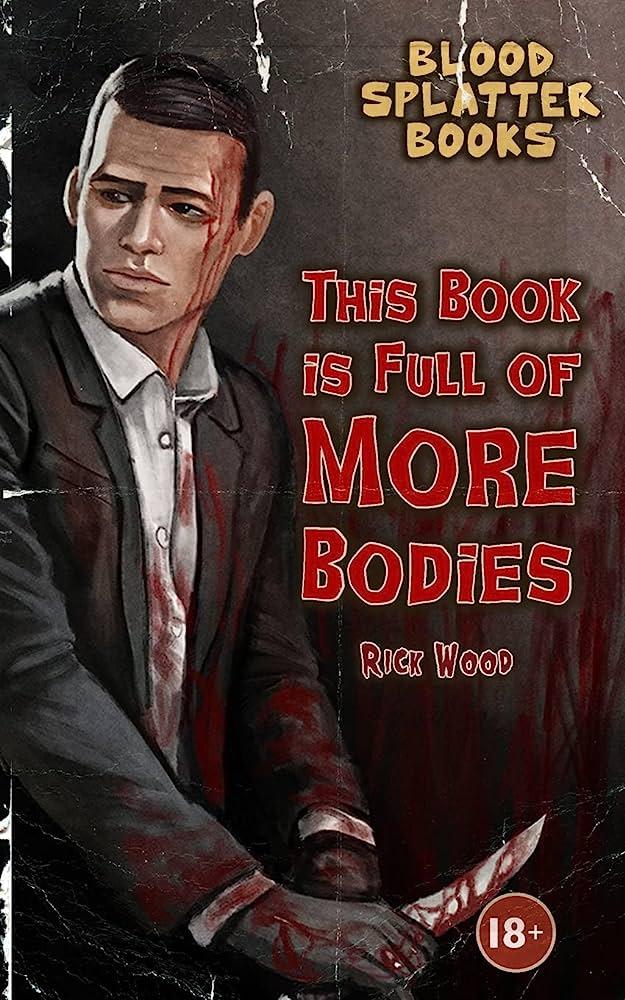Instant digital products (PDF, ePub, MOBI) ready for you
Download now and discover formats that fit your needs...
This Book is Full of More Bodies (Blood Splatter Books) Rick Wood
https://ebookmass.com/product/this-book-is-full-of-more-bodies-bloodsplatter-books-rick-wood/
ebookmass.com
This is Going to Hurt Adam Kay
https://ebookmass.com/product/this-is-going-to-hurt-adam-kay/
ebookmass.com
Budgeting and Financial Management for Nonprofit Organizations: Using Money to Drive Mission Success 1st Edition, (Ebook PDF)
https://ebookmass.com/product/budgeting-and-financial-management-fornonprofit-organizations-using-money-to-drive-mission-success-1stedition-ebook-pdf/ ebookmass.com
French phrase book Teach Yourself Books
https://ebookmass.com/product/french-phrase-book-teach-yourself-books/
ebookmass.com
NoSQL Essentials: Navigating the World of Non-Relational Databases Kameron Hussain & Frahaan Hussain
https://ebookmass.com/product/nosql-essentials-navigating-the-worldof-non-relational-databases-kameron-hussain-frahaan-hussain/
ebookmass.com
Lehninger Principles of Biochemistry 8th edition David L Nelson
https://ebookmass.com/product/lehninger-principles-ofbiochemistry-8th-edition-david-l-nelson/
ebookmass.com
Business
Ethics: Decision Making for Personal Integrity & Social Responsibility 4th Edition Laura Hartman
https://ebookmass.com/product/business-ethics-decision-making-forpersonal-integrity-social-responsibility-4th-edition-laura-hartman/
ebookmass.com
Macroeconomics 21st Edition, (Ebook PDF)
https://ebookmass.com/product/macroeconomics-21st-edition-ebook-pdf/
ebookmass.com
World Dance Cultures: From Ritual to Spectacle 1st Edition – Ebook PDF Version
https://ebookmass.com/product/world-dance-cultures-from-ritual-tospectacle-1st-edition-ebook-pdf-version/
ebookmass.com
This Is Beyond Budgeting
A Guide to More Adaptive and Human Organizations
Bjarte Bogsnes
Copyright © 2023 by Bjarte Bogsnes. All rights reserved.
Published by John Wiley & Sons, Inc., Hoboken, New Jersey. Published simultaneously in Canada.
No part of this publication may be reproduced, stored in a retrieval system, or transmitted in any form or by any means, electronic, mechanical, photocopying, recording, scanning, or otherwise, except as permitted under Section 107 or 108 of the 1976 United States Copyright Act, without either the prior written permission of the Publisher, or authorization through payment of the appropriate per-copy fee to the Copyright Clearance Center, Inc., 222 Rosewood Drive, Danvers, MA 01923, (978) 750-8400, fax (978) 750-4470, or on the web at www.copyright.com. Requests to the Publisher for permission should be addressed to the Permissions Department, John Wiley & Sons, Inc., 111 River Street, Hoboken, NJ 07030, (201) 748-6011, fax (201) 748-6008, or online at http://www.wiley.com/go/permission.
Trademarks: Wiley and the Wiley logo are trademarks or registered trademarks of John Wiley & Sons, Inc. and/or its affiliates in the United States and other countries and may not be used without written permission. All other trademarks are the property of their respective owners. John Wiley & Sons, Inc. is not associated with any product or vendor mentioned in this book.
Limit of Liability/Disclaimer of Warranty: While the publisher and author have used their best efforts in preparing this book, they make no representations or warranties with respect to the accuracy or completeness of the contents of this book and specifically disclaim any implied warranties of merchantability or fitness for a particular purpose. No warranty may be created or extended by sales representatives or written sales materials. The advice and strategies contained herein may not be suitable for your situation. You should consult with a professional where appropriate. Further, readers should be aware that websites listed in this work may have changed or disappeared between when this work was written and when it is read. Neither the publisher nor authors shall be liable for any loss of profit or any other commercial damages, including but not limited to special, incidental, consequential, or other damages.
For general information on our other products and services or for technical support, please contact our Customer Care Department within the United States at (800) 762-2974, outside the United States at (317) 572-3993 or fax (317) 572-4002.
Wiley also publishes its books in a variety of electronic formats. Some content that appears in print may not be available in electronic formats. For more information about Wiley products, visit our web site at www.wiley.com.
Library of Congress Cataloging-in-Publication Data
Names: Bogsnes, Bjarte, author.
Title: This is beyond budgeting : a guide to more adaptive and human organizations / Bjarte Bogsnes.
Description: Hoboken, New Jersey : John Wiley & Sons, Inc., [2023] | Includes index.
Identifiers: LCCN 2022053747 (print) | LCCN 2022053748 (ebook) | ISBN 9781394171248 (hardback) | ISBN 9781394171255 (adobe pdf) | ISBN 9781394171637 (epub)
Subjects: LCSH: Management. | Organizational effectiveness. | Organizational change. | Organizational behavior. | Organizational sociology.
Classification: LCC HD31.2 .B64 2023 (print) | LCC HD31.2 (ebook) | DDC 658—dcundefined
LC record available at https://lccn.loc.gov/2022053747
LC ebook record available at https://lccn.loc.gov/2022053748
Cover Design: Wiley
Author Photo by Christian Elfstrøm
For Robin
To build this new management model, we must start by radically reimagining the budgeting process—bureaucracy’s central nervous system. It is through the annual budgeting wrangle that priorities get defined, targets get set and resources get allocated. Arguably, no other process has a bigger impact on organizational performance—and at the moment, the performance of many organizations is lackluster at best.
Years ago, with the late C. K. Prahalad, I wrote an article for the Harvard Business Review titled “The Core Competence of the Corporation.” If I were writing that article today, I would call it “The Core Incompetence of the Corporation.”
When I look around the world, virtually every large organization is afflicted with the same disabilities: they are timid, inertial, and incremental. Typically, large institutions are content with single percentage point gains in revenue and profit growth. They’re reactive and are often years late in intercepting new trends. They invariably overinvest in legacy business while starving new ideas of resources. Budgeting is at the heart of all these failures. As a process, it’s a backwardlooking, internally focused, and highly politicized. It discourages boldness, perpetuates the past, and rewards mediocrity.
Put simply, we’ll never build fundamentally more capable organization unless we raze the traditional budgeting process and build something better in its place. That’s why Bjarte’s work, and this book, are so important.
The good news is that there are powerful, practical alternatives to budgeting as usual—radical new approaches that can help your organization aim higher, move faster, and take control of its own destiny. The bad news is that changing the
Foreword
Soon the bike is covered in dust, like the yoga mat in the closet and the barbells under the bed.
Given all this, you need to keep one central point in mind as you read this book: the transformative power of Beyond Budgeting is less about tools (as valuable as they are) and more about principles—like purpose, transparency, autonomy, and trust. Beyond Budgeting isn’t a set of techniques for improving the way bureaucracy works; it’s a set of principles for upending the bureaucratic status quo and reversing the “controlism” that undermines organizational resilience and creativity. An organization that works diligently to operationalize these principles will end up looking almost nothing like its bureaucratic peers. It will be flatter, leaner, simpler, faster, and radically more empowered.
You will find plenty in this book about how to get from here to there. But for now, let me note that you will need to think both big and small—you’ll need an approach that is both revolutionary and evolutionary. Back in the 1960s, putting a human being on the moon was an audacious goal, but Neil Armstrong’s “giant leap for mankind” was the culmination of many much smaller steps. So it is with reinventing budgeting. You must first commit to a lofty goal—ridding your organization of bureaucracy and the fiction that more elaborate budgets yield more control—and then find a way of moving forward through small, risk-bounded steps.
As you’ll learn, there is nothing conceptually difficult about Beyond Budgeting, nor is there any doubt about the payoff, if you take the idea seriously. Fact is, the challenges of replacing the traditional budget with built-for-purpose
Foreword
Nevertheless, the challenge of reshaping executive behaviors and reimagining management processes isn’t for the faint-hearted. The journey requires curiosity, audacity, and perseverance. Leaders need to be open to the possibility that tomorrow’s most successful organizations will be as different from today’s stratified, rule-choked leviathans as YouTube is different from broadcast television or PayPal is different from a checkbook. Leaders must be willing to venture beyond the safe precincts of conventional wisdom and experiment with bold new approaches to planning, target-setting, and control. They must believe, in the deepest recesses of their hearts, that human beings need and deserve organizations that are fundamentally more capable than the ones we have right now—and must be willing to put their shoulder to the plough to make this happen. I hope that’s you. If it is, you’ll find a heaping portion of encouragement, wisdom, and advice in the pages that follow.
Professor Gary Hamel London Business School
Foreword processes, while considerable, are relatively modest when compared to a major IT overhaul or a typical, top-down “transformation program.”
It all started in the mid-1990s at Borealis, at the time Europe’s largest petrochemicals company. The company was partly owned by Statoil and headquartered in Copenhagen. I headed up the corporate finance team. We were all challenged to think of new, different, and better ways of doing our work and of running the company. Our proposal to kick out the budget felt scary. We had not heard of anyone else doing this. We got a “yes,” provided we could find an alternative. Beyond Budgeting was not yet born, so we went looking for possible solutions.
After a lot of searching (no Google back then!), many discussions, and some dead ends, we finally cracked it. “Why do we budget?” was the simple question we needed to ask. The answer, which I will return to later, provided us with all we needed. Borealis became one of the inspirations for Jeremy Hope (RIP) and Robin Fraser, the founders of the Beyond Budgeting Roundtable. I later became the chairman of this international network of organizations and individuals interested in Beyond Budgeting.
After heading up finance, I moved to a similar role in human resources before returning to Statoil. I am probably one of very few having worked in both these functions. Those HR years had a big influence on my Beyond Budgeting journey. I will revert to why the two need to work much more closely together.
In my new role as corporate controller for Statoil’s international business I could not resist challenging my colleagues
This Is Beyond Budgeting
Why This Book?
Some of you might know that I already authored two books. Implementing Beyond Budgeting was published in 2008 and later in a significantly revised second edition in 2016. These books are about Beyond Budgeting, great cases, and my own journey and implementation experiences.
So why another book?
The previous books have done well, with readers all over the world. These include executives and senior managers. I know because of nice feedback from many of them. Still, they represent a minority of my readers, for the simple reason that they are terribly busy people. There are so many great books out there. Reading them all is a luxury few can squeeze into hectic schedules. If you are one of them, this is on purpose a short book, something that could be read on a flight, for instance, one of the few occasions left without meetings and phone calls.
My own insights and experiences keep evolving. I have now worked with even more great organizations and have written several articles that this book also draws on. So much has happened since the last book; I just have to share it!
The pressure on executive teams today is immense. They keep being challenged by stakeholders about the need for change and radical transformation. The pressure is not just about becoming greener and more sustainable. It is also about becoming more dynamic and adaptive. There is a jungle of models and thousands of books claiming to have the answer. No wonder many feel overwhelmed and confused.
This Is Beyond Budgeting
Many respond by embarking on an agile transformation journey. Most discover that agile wasn’t designed as a way to run an organization. Its original purpose was to improve how software was developed and how teams worked, which it did, very successfully. But when scaling agile, its “holes” become visible.
Beyond Budgeting fills these holes because it was intended and designed as an agile way of managing an organization. Many companies on transformation journeys are therefore reaching out to us. I hope this book can help even more executive teams understand that there can be no true agile transformation without Beyond Budgeting.
The same goes for Lean, which was born in manufacturing. Lean has also many similarities with Beyond Budgeting, such as trusting those closest to the situation to make the right decisions. But when scaling to enterprise Lean, holes appear also here. Again, Beyond Budgeting can fill these.
The COVID-19 pandemic was an eye-opener for many about the shortcomings of traditional and budget-based management. Seldom have so many budgets become irrelevant so fast. We have faced turmoil before, but the pandemic was different. Earlier times, for instance, the 2008 financial crisis, challenged only one of the assumptions behind traditional management: that the future is predictable and plannable. So many working from home during the pandemic challenged also the second assumption: that people can’t be trusted. But they could! A few anecdotal examples of the opposite carry no credible evidence.
Introduction
others. There are also other books to learn from. Beyond Budgeting, written by Jeremy Hope and Robin Fraser in 2003, is a classic. I also recommend Steve Morlidge’s great books on a range of Beyond Budgeting topics. Check also out The Viable Map Workbook published by the Beyond Budgeting Institute. More about the Viable Map and the book in Chapter 8.
I am sure you are curious about what you need to do differently when going Beyond Budgeting. Don’t worry; you will get it. There is no rocket science. But changing what we do helps little unless we also change how we think. This is the hardest part and should be your most important reason for reading this book.
If you already read any of my books, you may recognize some messages and stories. The purpose of this one is to condense these and make them more accessible for busy people, while also sharing new experiences and insights. I sincerely hope those who need to read it find the time. For those already onboard, but your managers or colleagues aren’t, maybe this book could help?
As you may know, or will discover, Beyond Budgeting is about much more than budgets. It is a comprehensive model, addressing both leadership principles and management processes, and the importance of coherence between the two. Believing that Beyond Budgeting is just about budgets is as wrong as believing that agile is just about software. Beyond Budgeting challenges traditional management, which has the budgeting process and the budgeting mindset of prediction and distrust at its core. Hence the name.
Introduction
Many have challenged us about finding a better name. We are open to it, but only if a new one is significantly better. If you have a proposal, please let us know!
In the meantime, we will stick with Beyond Budgeting. It has become a brand. It creates attention, and even provokes some. If we can use this attention to explain what Beyond Budgeting really is about, then the name might have served its purpose.
This book starts with reflections on a few topics I find intriguing, a warm-up to what follows. What does “control” really mean, for instance?
We take a closer look at the many problems associated with the budgeting process and the budgeting mindset, before we move to Beyond Budgeting as a solution to these and many other traditional management problems, including those associated with targets. Individual bonus amplifies these problems, so I can’t help having another go at this flawed management idea. And by the way, do we really need targets? That important question will also be explored.
We then discuss who Beyond Budgeting is for, who is on the journey, and a question we keep getting: Can Beyond Budgeting work in the public sector? Spoiler alert! The answer is “yes.”
As discussed, there are many similarities between Beyond Budgeting and agile. The budget is the elephant in the room on agile transformation journeys. This overlooked fact will be addressed. We will also look at similarities, differences, and issues with OKRs (objectives and key results) and with psychological safety. Let me already now make it clear that
This Is Beyond Budgeting










